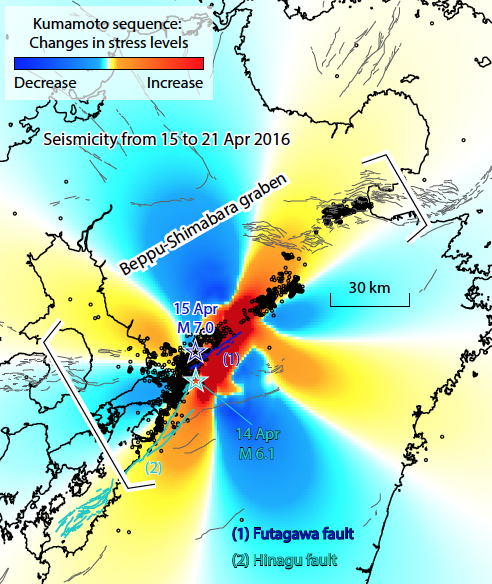The concept behind a theme park’s Tipping Bucket water game is simply this: water drips slowly into a bucket and when it becomes completely filled, it tips over to splash the people beneath it.
An earthquake fault acts in the same way. Tectonic stress from a plate’s motion gradually accumulates on the fault plane until it hits a critical level, causing the fault to rupture and generate an earthquake.
Similarly, one could look at a fault system as being made up of many tipping buckets of different sizes with different filling rates, and containing different amounts of water. When a big earthquake occurs, the ruptured fault will transfer some degree of tectonic stress to nearby faults. To understand this, imagine a large bucket of water tipping over and splashing its contents into the smaller buckets below, which then tip over too.
The effect of transferring water from one bucket to several others in a chain reaction during the splash is called the Coulomb Stress Transfer. It has been observed by scientists for more than two decades and has been widely used to describe the aftershock distributions that result from a big earthquake.
Scientists were able to model and observe the effects of the Coulomb Stress Transfer in the April 2016 Kumamoto earthquake sequence. Not only did it trigger aftershocks around the mainshock’s epicentre, it also activated some distant faults not directly connected to the ruptured fault.
From the first-order of the Coulomb stress model for the earthquake sequence, it was observed that most of the Kumamoto aftershocks occurred within the region of the rupture in the Futagawa fault. These coincide with the location of Beppu-Shimabara graben, where multiple active East-West-running faults can be seen on the ground surface. This is a cause of growing concern for scientists as it indicates that the active fault in the Beppu-Shimabara graben could be triggered in the near future.

According to the stress model, the magnitude-7.0 mainshock on 15 April 2016 (UTC) did not produce a significant increase in aftershocks along the southern extension of the Hinagu fault as was observed in the first few days. However, there was a significant increase in tectonic stress in both the northeastern part of Kyushu Island and the southwestern extension of the Futagawa-Hinagu fault. Because the epicentre of the recent aftershocks appear to have migrated southwestward, there is concern that the southern extension of the Futagawa-Hinagu fault, which hasn’t ruptured in thousands of years, could be triggered by a mainshock.
This type of a “chain reaction” along the long-sleep fault system is not rare. One of the better-known chain-reacted events that took place from 1992 to 1999 is the Landers/Big Bear/Joshua Tree/Hector Mine earthquake sequence. The 2011 Tohoko-Oki earthquakes serve as another example of a rupture in a long-sleeping inland normal fault, where a magnitude-9.0 mainshock from the subduction zone triggered the magnitude-7.0 Fukushima earthquake.
Due to the long lapse in time since the last rupture in the southern segment of the Futagawa-Hinagu fault, the probability of another occurrence of a rupture is expected to be high at up to 16 % in the next three decades as determined by Japan’s Headquarters for Earthquake Research Promotion. In the case of the Kumamoto sequence, the evidence observed from the aftershock sequence and the stress evolution model all point to an impending rupture in the fault segment. In other words, the continuous and frequent aftershocks along the Futagawa-Hinagu fault indicate that there is a high chance of another significantly large earthquake occurring in the same region within the next 30 years.